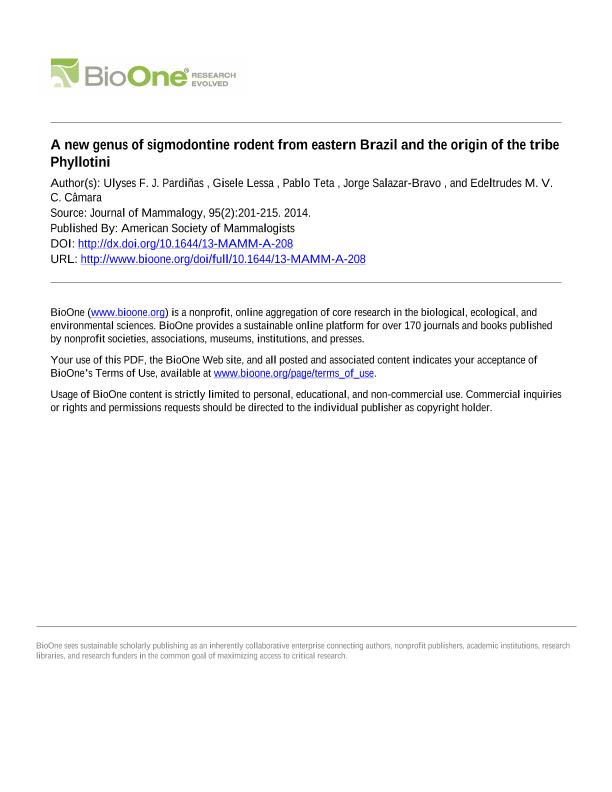Artículo
We describe a new living genus and species of Sigmodontinae currently only known from the Brazilian National Park Sempre Vivas, Minas Gerais State. This rodent is characterized by a unique combination of traits that include, among others, a long tail, with its distal tip (approximately 2.5 to 5 cm) entirely white; skull with domed profile; long rostrum with an incipient rostral tube; and noticeable small brachyodont molars with reduced mesolophs and mesostyles present on the 1st and 2nd upper molars. Cladistic analyses of molecular (1 mitochondrial and 1 nuclear marker) and morphological characters indicate that the new genus belongs to the Phyllotini and is sister to the remainder genera of this tribe. However, contrary to other known phyllotines, the new genus shows vestigial mesolophs and mesostyles. Phyllotines are widespread in open areas, in particular desert and semideserts, mostly in the western portion of South America. The new genus described herein expands the diversity of the tribe and suggests an ancient event of diversification in eastern Brazil. Describimos un nuevo género y especie de Sigmodontinae actualmente sólo conocido para el Parque Nacional brasilero Sempre Vivas, Estado de Minas Gerais. Este roedor se caracteriza por una combinación única de rasgos que incluyen, entre otros, una cola larga con su porción distal (ca. 2,5 a 5 cm) enteramente blanca; cráneo con perfil abovedado; rostro largo con tubo rostral incipiente; molares braquiodontos notablemente pequeños con pequeños mesolofos y mesostilos presentes en los primeros y segundos molares superiores. Análisis cladísticos de caracteres moleculares (un marcador mitocondrial y un marcador nuclear) y morfológicos indican que el nuevo género pertenece a los Phyllotini y es hermano de los restantes géneros de la tribu. Sin embargo, contrariamente a los otros filotinos conocidos, el nuevo género muestra mesolofos y mesostilos vestigiales. Los filotinos están ampliamente distribuidos en zonas abiertas, en particular en desiertos y semidesiertos, mayormente en la porción occidental de América del Sur. El nuevo género aquí descripto expande la diversidad de la tribu y sugiere un antiguo evento de diversificación en Brasil oriental.
A new genus of sigmodontine rodent from Eastern Brazil and the origin of the tribe Phyllotini
Pardiñas, Ulises Francisco J. ; Lessa, Gisele; Teta, Pablo Vicente
; Lessa, Gisele; Teta, Pablo Vicente ; Salazar Bravo, Jorge; Câmara, Edeltrudes M. V. C.
; Salazar Bravo, Jorge; Câmara, Edeltrudes M. V. C.
 ; Lessa, Gisele; Teta, Pablo Vicente
; Lessa, Gisele; Teta, Pablo Vicente ; Salazar Bravo, Jorge; Câmara, Edeltrudes M. V. C.
; Salazar Bravo, Jorge; Câmara, Edeltrudes M. V. C.
Fecha de publicación:
04/2014
Editorial:
American Society of Mammalogists
Revista:
Journal of Mammalogy
ISSN:
0022-2372
e-ISSN:
1545-1542
Idioma:
Inglés
Tipo de recurso:
Artículo publicado
Clasificación temática:
Resumen
Palabras clave:
Brazil
,
Calomys
,
Cerrado
,
Cricetidae
,
Sigmodontinae
Archivos asociados
Licencia
Identificadores
Colecciones
Articulos(CCT-CENPAT)
Articulos de CTRO.CIENTIFICO TECNOL.CONICET - CENPAT
Articulos de CTRO.CIENTIFICO TECNOL.CONICET - CENPAT
Citación
Pardiñas, Ulises Francisco J.; Lessa, Gisele; Teta, Pablo Vicente; Salazar Bravo, Jorge; Câmara, Edeltrudes M. V. C.; A new genus of sigmodontine rodent from Eastern Brazil and the origin of the tribe Phyllotini; American Society of Mammalogists; Journal of Mammalogy; 95; 2; 4-2014; 201-215
Compartir
Altmétricas



